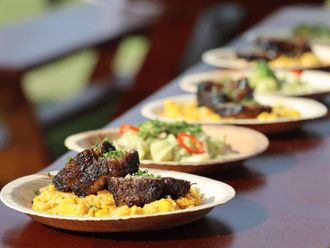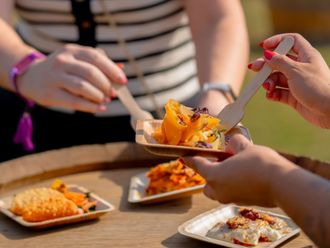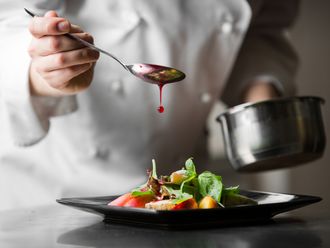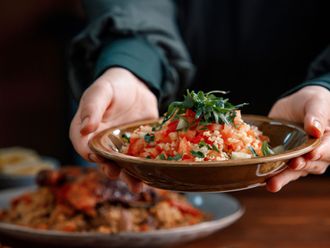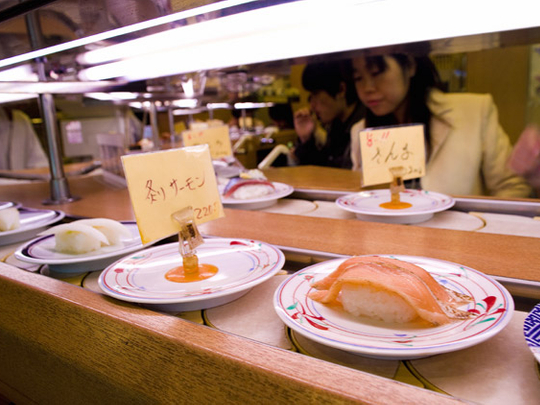
There's an empty black sky above the sparkling city, but I'm looking down at the stars. Michelin stars. In the 2011 Tokyo guide, the total number of stars was 348 - with 14 three-star rated venues, 54 two-star rated venues and 198 one-star rated venues, more than Paris, London and New York put together.
From the 52nd floor of the Park Hyatt Tokyo, they're somewhere below me, among thousands of other glittering restaurants that Michelin doesn't even know exist. In malls and side streets, hidden in multi-storey office and apartment blocks, behind unmarked doors and mysterious curtains, on neon-strafed streets.
Down there, the city sprawls in every direction - an endless concrete jumble of buildings, roads, cars, trains, shops, markets, some 13 million people and every variety of food you can imagine - as well as some you can't. Sushi, sashimi, ramen, gyoza, tempura, sukiyaki, okonomiyaki, yaki-niku, udon and more. It's the food of Tokyo, and Japan as a whole, that has drawn me to this fascinating country, and in the short time I have here, I intend to get my fill.
First, I savour the city view from the New York Grill. This is the Park Hyatt's flagship restaurant, an international steakhouse that offers the finest meat from around the globe, as well as the choicest cuts of the famous Japanese wagyu beef. Chef de cuisine Nadine Waechter Moreno and her team keep the recipes simple and the flavours bold. The restaurant and bar is sleek black and chrome, splashed with canvases of New York scenes by the Italian artist Valerio Adami. Add incredible 52nd floor vistas, made famous by the film Lost in Translation, and you've got yourself an essential Tokyo dining experience.
But there are tens, perhaps hundreds of essential Tokyo dining experiences - and many more beyond the capital. Take kaiseki, for example. The traditional haute cuisine of Kyoto, kaiseki is Japanese fine dining at its most elegant and refined. Many consider it an art form, a highly aesthetic expression of Japan's finest seasonal ingredients, preparation techniques, presentation and setting. Small, painstakingly prepared courses - usually vegetarian - are served, one after the other, often in the serene and beautiful surrounds of a traditional ryotei restaurant. It's possible to find kaiseki in Tokyo, but for the real thing, you have to head to Kyoto.
Before I do, I opt for something a little more down to earth. Ramen is the Chinese soup noodle dish that the Japanese have made their own. There are countless ramen shops in Tokyo, serving hordes of diners squeezed in at long bars, loudly slurping some of the tastiest and best value food to be found in the city - from between 500 and 1,000 Japenese yen (Dh45) a bowl.
The flour and egg noodles should be thin yet firm to the bite, and they can be topped with anything, from shrimp, chicken, to spring onions, nori seaweed and egg. A word of caution here - much ramen is served in a pork-based soup called tonkotsu, but a variety of broths can be found, from the soy-based shoyu ramen, to miso-flavoured soup. In keeping with Chinese tradition, ramen is often accompanied by gyoza, or fried dumplings stuffed with meat, vegetables and herbs. Along with soba, udon noodles, and okonomiyaki pancakes, it's Japanese soul food that no visitor should miss.
Another unmissable treat in Japan is sushi. Not the cold, soulless blocks of stodgy rice and tired tuna found on conveyor belts the world over, but real Japanese sushi. The kind that's handmade in front of you, and delivered portion-by-portion, using the "omakase" or "trust me" system, by which the chef prepares whatever he likes from that day's selection of fresh ingredients. It's the kind of sushi that respects texture and temperature as well as flavour and appearance; and it's the kind that will have you pining for real sushi and sashimi the minute you've left Japan.
Some of the finest sushi restaurants in Tokyo are tiny, secret places that only accept around five or six members each night. Even Michelin inspectors can't gain access to these exclusive sushi clubs, and they are said by the few non-Japanese to have dined there to be beyond exquisite. But there are still plenty of sushi restaurants open to non-members.
Sushisho Saito in Akasaka is a Michelin-star joint with an intimate sushi bar that serves no more than 12 people at a time. I am taken there by top Japanese food critic Yumiko Inukai, who explains each piece to me. "There's umi-budo sea grapes seaweed, horse mackerel sushi, and bonito with mayonnaise, ginger and green chilli; wild freshwater eel, abalone with pepper and malt paste, and mozuku seaweed with vinegar..." All of it is astoundingly delicious, or "oishi!" as the Japanese say. "One of the chefs here rides his bicycle to Tsukiji fish market every day," says Inukai. Which leads me to yet another essential Tokyo food experience.
Tsukiji is the world's largest fish market, a vast metropolis of sea creatures and crustaceans of every shape, size and colour. This is where you'll see fish you didn't even know existed among the hundreds of stalls. It's also where you'll see the famous bluefin tuna auctions held each morning, which means a 4am start for tourists.
It's worth staying up all night for, as the huge mist-strewn frozen tuna carcasses are inspected before being sold off to the highest bidder in a flurry of hand signals and paper-waving. The otoro cut from the tuna belly is heavily marbled with fat and considered to be the finest part of the fish. Make that judgement for yourself at breakfast in one of the small sashimi restaurants outside the main market. There you can compare the fatty otoro tuna with the leaner akamai cut. Whichever you prefer, you won't find fish much fresher in the whole of Japan.
With the creamy texture and rich flavour of otoro tuna still bouncing around my palate, I catch the famous Bullet Train from Tokyo to Kyoto to continue my Japanese food odyssey. I've been told that the Kansei region of western Japan is just as good as Tokyo when it comes to fantastic food. The Michelin star count in Kyoto is second only to the capital. And its neighbouring cities - Kobe, famed for its sumptuous wagyu beef, and Osaka, Japan's second largest city and a fast-food haven - are equally as absorbing for the travelling gastronome. Which is the problem with merely spending a few weeks in Japan: you only get a taste of the seemingly boundless variety of fine food on offer. But what a taste.
Where to eat:
For kaiseki, Sekiho-tei (03 5474 6889) has two Michelin stars, and offers set lunches for 5,000 Japanese yen (Dh220), and set dinners for 12,000 yen (Dh530) per head.
For Ramen, try Kyushu Jangara (Harajuku; 03 3404 5572), which is tiny yet friendly, with English menus and fine ramen.
Sushisho Saito (Akasaka, 03 3505 6380) is an education in real Japanese sushi and sashimi, but the hidden restaurant is hard to find so ask around.
Where to stay:
If you can afford it, splash out at the legendary Park Hyatt Tokyo (3-7-1-2 Nishi Shinjuku, Shinjuku-tu, 03 5323 3458, www.tokyo.park.hyatt.com) as featured in the film Lost in Translation and pretend you're Bill Murray/Scarlett Johansson for at least one night.
Considerably cheaper, though still clean and comfortable, is the Toyoko Inn, which has many branches around Tokyo and the rest of Japan. It has two properties in Ikebukuro, a lively area of Tokyo, with excellent train and subway links (around Dh300 per night, www.toyoko-inn.com).
What to see:
Most of Tokyo's main attractions can be reached on the JR Yamanote Line, which circles the city. But from the frenetic commercial districts of Shibuya and Shinjuku, to the fashion emporia of Harajuku and the techie wonderland that is Akihabara, Tokyo is best discovered on foot.
What to buy:
As sharp as a Samurai sword, Sugimoto knives are magnificent, whether you're a budding sushi chef or an amateur in need of a cutting edge. Established in the 1830s, the shop near Tsukiji fish market has been there since the new market opened in 1935 (www.sugimoto-hamono.com).
How to get there: Emirates flies direct to Tokyo Narita airport from Dh5,655. Malaysia Airlines flies via Kuala Lumpur from Dh3,562.
How to be cool at a Japanese dinner
1. In Japan, say itadakimasu (I gratefully receive) before you begin, and gochisosama (deshita) (thank you for the meal) after you finish.
2. Don't point your chopsticks at other people while talking. Leaving your chopsticks sticking up out of your bowl, is considered rude.
3. Once you finish, try to move all your dishes back to the same position they were at the start of the meal, replace the lids on dishes and place the chopsticks back on the chopstick holder.
4. Avoid using "chin chin" when raising a toast, since in Japanese this expression refers to the male genitals!
5. It is considered rude to waste soy sauce.
6. Always eat the sushi in one bite. If the sushi is meant to be dipped in sauce, only dip the fish part, not the rice.
7. Don't pour your own. Your friends fill yours while you refill their drinks.



